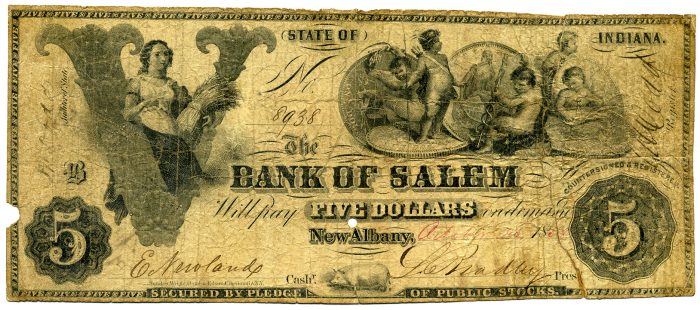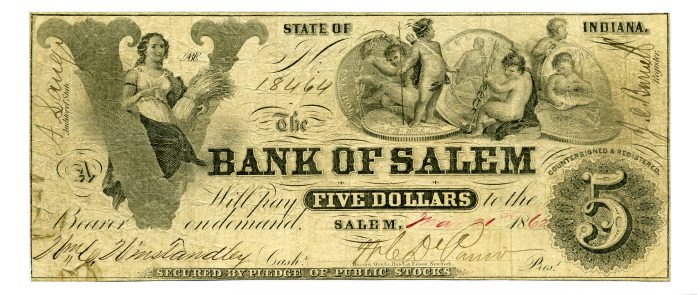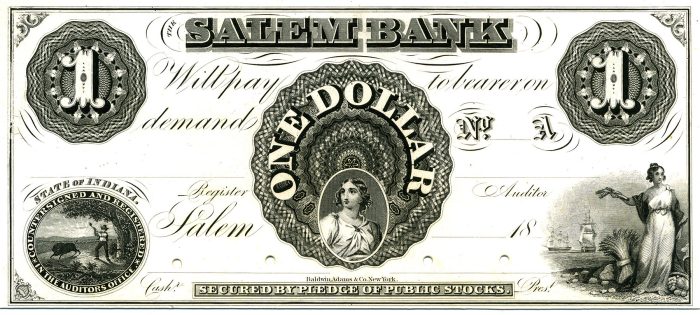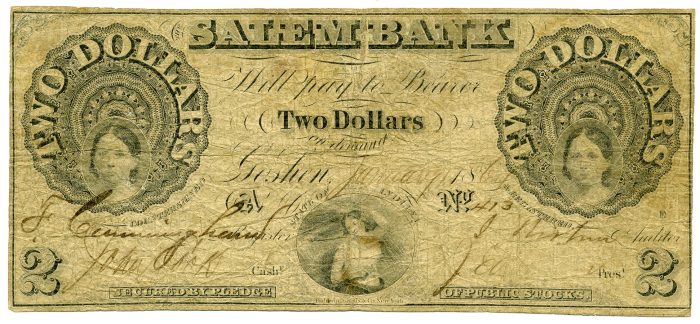Double Trouble
Salem, Indiana, is the county seat of Washington County in southern Indiana. Founded in 1814, the town’s main claim to fame is that it was pillaged by John Hunt Morgan’s Confederate cavalry on July 10, 1863. The Bank of Salem was established in 1854 as a state-authorized free bank. Its circulation was secured by various state “stocks” (known today as bonds), which could be used to redeem the bank’s notes if it failed or refused to redeem its circulation for some other reason.
The Bank of Salem
The Bank of Salem had a branch in nearby New Albany, a busy Ohio River town about 32 miles away, that also issued notes. Unlike most of their Indiana free bank peers, both locations were capably and conservatively managed and were quite successful. Both survived the Civil War (although the Salem location surely must have suffered some losses during the aforementioned Confederate raid). Both locations were still doing business under the state’s free banking laws at least as late as 1875, although neither had been issuing bank notes for probably the better part of a decade. In 1868 the Salem location burned the last of its outstanding notes, while the last recorded outstanding circulation for its New Albany branch was $1,868 as of October 31, 1875.
Today, surviving Bank of Salem notes are primarily Salem-datelined proofs that were part of the American Bank Note Company archives sold in 1990. Additionally, a couple of heavily canceled notes from Salem somehow escaped the fiery furnace. An issued but uncanceled $5 from the Salem location and two issued $5s from New Albany also survived.


The Salem Bank
The situation became more complicated with the organization of The Salem Bank in Goshen in 1854. Goshen is located at essentially the opposite end of Indiana in Elkhart County, whose northern boundary is the Michigan state line. The bank, like its southern Indiana counterpart, also had a branch located in—you guessed it—Salem, which was 10 miles or so southwest of Goshen.
The northern Indiana hamlet of Salem was founded around 1852 and retained its name when The Salem Bank was organized in 1854. The United States Post Office was forced to step in after complaints of missent mail started to accumulate. The existence of two Salem post offices was a problem. Since the southern Indiana Salem was there first, the Elkhart County Salem ended up changing its name to Wakarusa in 1859. According to residents, Wakarusa meant “knee deep in mud” in the local Native American language. This may explain why the branch was located there. Banks sometimes tried to protect themselves from unwelcome visits by so-called “carpetbaggers” (a term used to describe people who showed up with carpet bags full of bank notes demanding redemption in gold or silver) by choosing locations that were difficult to get to or even find. Given The Salem Bank’s careful conservative management, no carpetbagger ever successfully challenged the bank’s ability to redeem its notes. The branch was closed in 1865 when all operations were transferred to the main office in Goshen.


The Salem Bank weathered the Civil War and subsequent financial disruptions. In 1875 the outstanding circulation for notes datelined both Goshen and Salem (no Wakarusa notes apparently were issued) totaled a minuscule $379. Circulating note designs for both Goshen and Salem (Wakarusa) were identical except for the place of issue. Most surviving examples for this bank are proofs datelined Salem that were part of the American Bank Note Company holdings sold in 1990. A handful of issued notes datelined Goshen have survived, in addition to perhaps three or four Salem-datelined issued $5s. The Salem Bank has, in fact, survived to the present day, although it has undergone several modern-day mergers and is now part of KeyBank.
So, there you have the story of two very successful free banks located in Indiana towns that shared the same name. The Bank of Salem was headquartered in Salem with a branch in New Albany, and the Salem Bank headquartered in Goshen had a branch in Salem (now Wakarusa). You can see why there could be some confusion as to which bank was which, even though they were located at opposite ends of the state and were separated by over 250 miles. And so it goes in the wild and wonderful world of obsolete paper money, where you can’t make this stuff up.
A version of this article appears in the April 2024 issue of The Numismatist (money.org).
